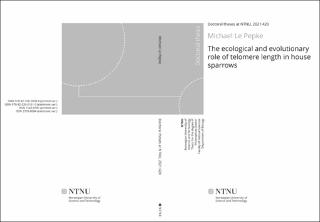| dc.contributor.advisor | Ringsby, Thor Harald | |
| dc.contributor.advisor | Jensen, Henrik | |
| dc.contributor.advisor | Wright, Jonathan | |
| dc.contributor.advisor | Kvalnes, Thomas | |
| dc.contributor.author | Pepke, Michael Le | |
| dc.date.accessioned | 2022-02-01T12:59:54Z | |
| dc.date.available | 2022-02-01T12:59:54Z | |
| dc.date.issued | 2021 | |
| dc.identifier.isbn | 978-82-326-5161-0 | |
| dc.identifier.issn | 2703-8084 | |
| dc.identifier.uri | https://hdl.handle.net/11250/2976281 | |
| dc.description.abstract | Telomeres, the DNA sequences capping the ends of linear chromosomes, are ancient molecular structures that are shared among most eucaryotes. The telomeres protect chromosomes from degradation and are vital to genome integrity. Telomeres shorten with each cell division, and due to oxidative stress-inducing processes. Short telomeres are predictive of poor health and reduced survival in some animals. Thus, telomere length (TL) may underpin life-history trade-offs between growth, survival, and reproduction, or act as a biomarker of individual quality or pace-of-life. However, the ecological and evolutionary role of TL in shaping variation in life-history traits in wild animals is not well-known. In this thesis, I investigated causes and consequences of TL variation in populations of wild house sparrows.
I found that TL was negatively associated with body size both during an artificial size selection experiment and in natural populations. However, this association was not due to a negative genetic correlation between TL and body size. There was a small heritable component of early-life TL, but variation in TL among individuals was mainly driven by environmental (annual) variance. Inbred sparrows had short telomeres. Furthermore, I identified several novel putative genes underlying variation in TL. Early-life TL was shaped by effects of weather conditions and population density, but there was no strong evidence for associations between TL and fitness components. Individuals with shorter early-life TL tended to have higher reproductive output and higher chances of successful dispersal as expected if TL reflects pace-of-life syndromes. TL generally shortened with age but was apparently elongated within some individuals. There was a moderate heritability of the change in TL within individuals and large cohort effects on the change in TL. Thus, selection on TL or the telomere rate of change may produce evolutionary change in TL over time and annual environmental stochasticity in early-life will generate persistent heterogeneity in TL among cohorts. Across bird species, TL was significantly negatively associated with the fast-slow axis of life-history variation, suggesting that TL may have evolved to mediate trade-offs between physiological requirements underlying the diversity of pace-of-life strategies.
In conclusion, TL in house sparrows is a dynamic, heritable, polygenic trait that is negatively affected by growth, inbreeding, and environmental stressors during early-life, but the evidence that the fate of the telomere reaches beyond itself, the cell, and the organism is equivocal. Indeed, early-life TL may reveal subtle long-term costs of early life-conditions and may act as a biomarker of pace-of-life both within house sparrows and across bird species. | en_US |
| dc.language.iso | eng | en_US |
| dc.publisher | NTNU | en_US |
| dc.relation.ispartofseries | Doctoral theses at NTNU;2021:420 | |
| dc.relation.haspart | Paper 1: Pepke, M.L.,Kvalnes, T., Rønning, B., Jensen, H., Boner, W., Sæther, B.-E., Monaghan, P., & Ringsby, T.H. (2021) Artificial size selection experiment reveals telomere length dynamics and fitness co nsequences in a wild passerine, Authorea preprint,
https://doi.org/10.22541/au.161447476.67562312/v1 Published in Molecular Ecology. https://doi.org/10.1111/mec.16340 | en_US |
| dc.relation.haspart | Paper 2: Pepke, M.L., Kvalnes, T., Lundregan, S., Boner, W., Monaghan, P., Sæther, B.-E., Jensen, H. §, & Ringsby, T.H. § (2021) Genetic architecture and heritability of early-life telomere length in a wild passerine, Authorea preprint,
https:/doi.org/10.22541/au.161961744.48479988/v1 | en_US |
| dc.relation.haspart | Paper 3: Pepke, M.L., Niskanen, A., Kvalnes, T., Boner, W., Sæther, B.-E., Ringsby, T.H. §, & Jensen, H. § (2021) Inbreeding is associated with shorter early-life telomere length in a wild passerine, bioRxiv preprint, https://doi.org/10.1101/2021.10.10.463797 3 | en_US |
| dc.relation.haspart | Paper 4: Pepke, M.L., Kvalnes, T., Ranke, P.S., Araya-Ajoy, Y.G., Wright, J., Sæther, B.-E., Jensen, H., & Ringsby, T.H. (2021) Causes and consequences of variation in early-life telomere length in a bird metapopulation, EcoEvoRxiv preprint,
https://doi.org/10.32942/osf.io/9zctr | en_US |
| dc.relation.haspart | Paper 5: Pepke, M.L.,Kvalnes, T., Araya-Ajoy, Y.G., Ranke, P.S., Wright, J., Sæther, B.-E., Jensen, H., & Ringsby, T.H. (manuscript) Longitudinal telomere dynamics in wild house sparrows. | en_US |
| dc.relation.haspart | Paper 6: Pepke, M.L., Ringsby, T.H., & Eisenberg, D.T.A. (2021) Early-life telomere length covaries with life-history traits and scales with chromosome length in birds, bioRxiv preprint,
https://doi.org/10.1101/2021.08.07.455497 | en_US |
| dc.title | The ecological and evolutionary role of telomere length in house sparrows | en_US |
| dc.type | Doctoral thesis | en_US |
| dc.subject.nsi | VDP::Mathematics and natural science: 400::Basic biosciences: 470 | en_US |

